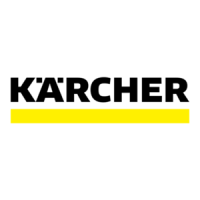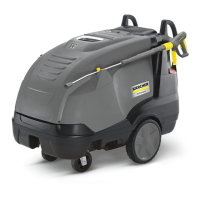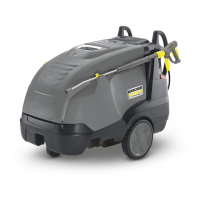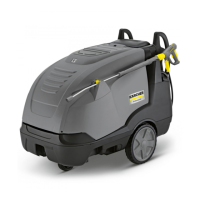Do you have a question about the Kärcher HDS 12/18-4 S and is the answer not in the manual?
Immediate danger causing severe injury or death.
Possible hazardous situation leading to severe injury or death.
Possible hazardous situation causing mild injury or property damage.
Identification and description of the machine's components (Figure 1).
Identification and description of the control panel elements (Figure 2).
Explanation of color coding for operating elements.
Explanation of safety symbols found on the appliance.
Warnings about potential injuries when operating the appliance.
Adherence to national rules for fuel jets and accident prevention.
Explanation of the overflow and safety valve functions.
Description of water shortage and temperature stop safeguards.
Procedure for installing the handle of the appliance.
Instructions for refilling the system care fluid.
Guidance on adjusting system care dosage based on water hardness.
Procedures for refilling the fuel tank and detergent.
Instructions for connecting the appliance to a water source.
Procedure for drawing water from an external vessel.
Connecting the appliance to the electrical power supply.
Important safety precautions and warnings for operating the appliance.
Procedure for replacing the spray nozzle.
Description of different operational modes and their functions.
Adjusting working pressure via the pump unit control.
Adjusting working pressure and feed quantity at the spray gun.
Step-by-step guide for effective cleaning.
Safety precautions and steps for safely shutting down the appliance.
Measures to protect the appliance during storage, especially in freezing conditions.
Essential safety steps before performing any maintenance tasks.
Procedures for cleaning various sieves and filters on the appliance.
Diagnosing issues indicated by the pump indicator lamp.
Troubleshooting for rotational direction and ready for use indicator lamps.
Diagnosing issues with engine and burner failure indicator lamps.
Troubleshooting service, fuel, system care, and detergent indicator lamps.
Troubleshooting issues related to detergent indicators and power supply.
Diagnosing problems with pressure, leaks, and intermittent operation.
Troubleshooting issues with detergent suction and burner ignition.
Addressing problems with temperature achievement and hot water operation.
| Cable length | 5 m |
|---|---|
| Fuel tank capacity | 25 L |
| Connected load | 8400 W |
| AC input voltage | 420 V |
| Number of phases | 3 |
| AC input frequency | 50 Hz |
| Working pressure (max) | 180 bar |
| Working pressure (min) | 30 bar |
| Heating oil/gas consumption (full load) | 7.7 kg/h |
| Depth | 750 mm |
|---|---|
| Width | 1330 mm |
| Height | 1060 mm |
| Weight | 178000 g |












